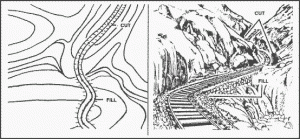Hill - A hill is an area of high ground. From a hilltop, the ground slopes down in all directions. A map shows a hill by contour lines forming concentric circles. The inside of the smallest closed circle is the hilltop.
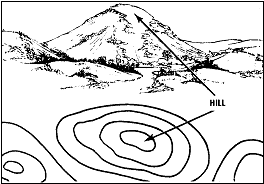
Saddle - A saddle is a dip or low point between two area of higher ground. A saddle is not necessarily the lower ground between two hilltops – it may be simply a dip or break along a level ridge crest. If you are in a saddle, you see high ground in two opposite directions and lower ground in the other two directions. Contour lines for a saddle normally resemble an hour glass.
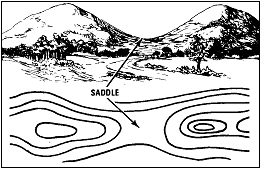
Valley - A valley is a stretched-out groove in the land, usually formed by streams or rivers. A valley begins with high ground on three sides, and usually has a course of running water through it. If you are standing in a valley, three directions offer high ground, while the fourth direction offers low ground. Depending on the valley size and where you are standing, you may not see high ground in the third direction, but water flows from higher ground to lower ground. Contour lines forming a valley are either U-shaped or V-shaped. To determine the direction the water is flowing, look at the contour lines. The closed end of the contour line (U or V) always point upstream towards the high ground.
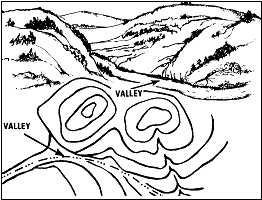
Ridge - A ridge is a sloping line of high ground. If you are standing on the centerline of a ridge, you will normally have low ground in three directions and high ground in one direction with varying degrees of slope. If you cross a ridge at right angles, you will climb steeply to the crest and then descend steeply to the base. When you move across the path of a ridge, depending on the location, you may find either an almost unnoticeable slope or a very obvious incline. Contour lines forming a ridge tend to be U-shaped or V-shaped. The closed end of the contour line points away from high ground.
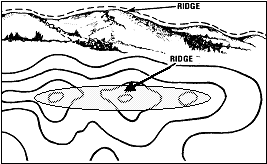
Depression - A depression is a low point in the ground or a sinkhole. It could be an area of low ground surrounded by higher ground in all directions, or simply a hole in the ground. A map usually shows only depressions that are equal to or greater than the contour interval. Depressions are represented by closed contour lines that have tick marks pointing towards the low ground.
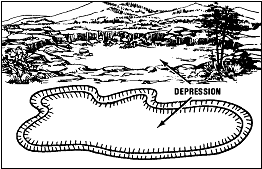
Draw - A draw is a less developed stream course than a valley. A draw offers no level ground and, therefore little or no maneuvering rooms while in its confines. If you are standing in a draw, the ground slopes upwards in three directions and downward in the other direction. The contour lines depicting a draw are U-shaped or V-shaped, pointing toward high ground.
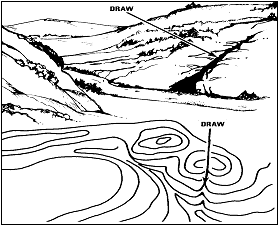
Spur - A spur is a short, continuous sloping line of higher ground, normally jutting out from the side of a ridge. A spur is often formed by two rough parallel streams, which cut draws down the side of a ridge. The ground slopes down in three directions and up in one direction. Contour lines on a map depict a spur with the U or V pointing away from the high ground.
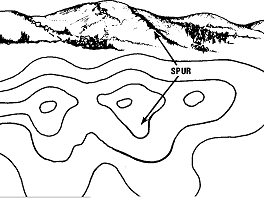
Cliff - A cliff is a vertical or near-vertical feature. It is an abrupt change of the land’s elevation. When a slope is so steep that the contour lines converge into one “carrying” contour of contours, this last contour line has tick marks pointing toward low ground. Contour line very close together or touching each other also indicate cliffs.
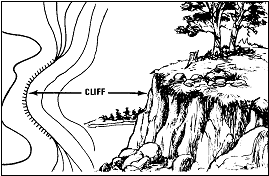
Cut - A cut is a man-made feature that results from cutting through raised ground, usually to form a level bed for a road or railroad track. Cuts are shown on a map when they are at least ten feet high. They are drawn with a contour line along the cut line. This contour line extends the length of the cut and has tick marks from the cut line to the roadbed, if the map permits this level of detail.
Fill - A fill is a man-made feature that results from filling a low area, usually to for a level bed for a road or railroad track. Fills are shown on a map when they are at least ten feet high. They are drawn with a contour line along the fill line. This contour line extends the length of the filled area and has tick marks that point toward the lower ground. If the map scale permits, the length of the fill’s tick marks are drawn to scale and extend from the base line of the fill symbol.
